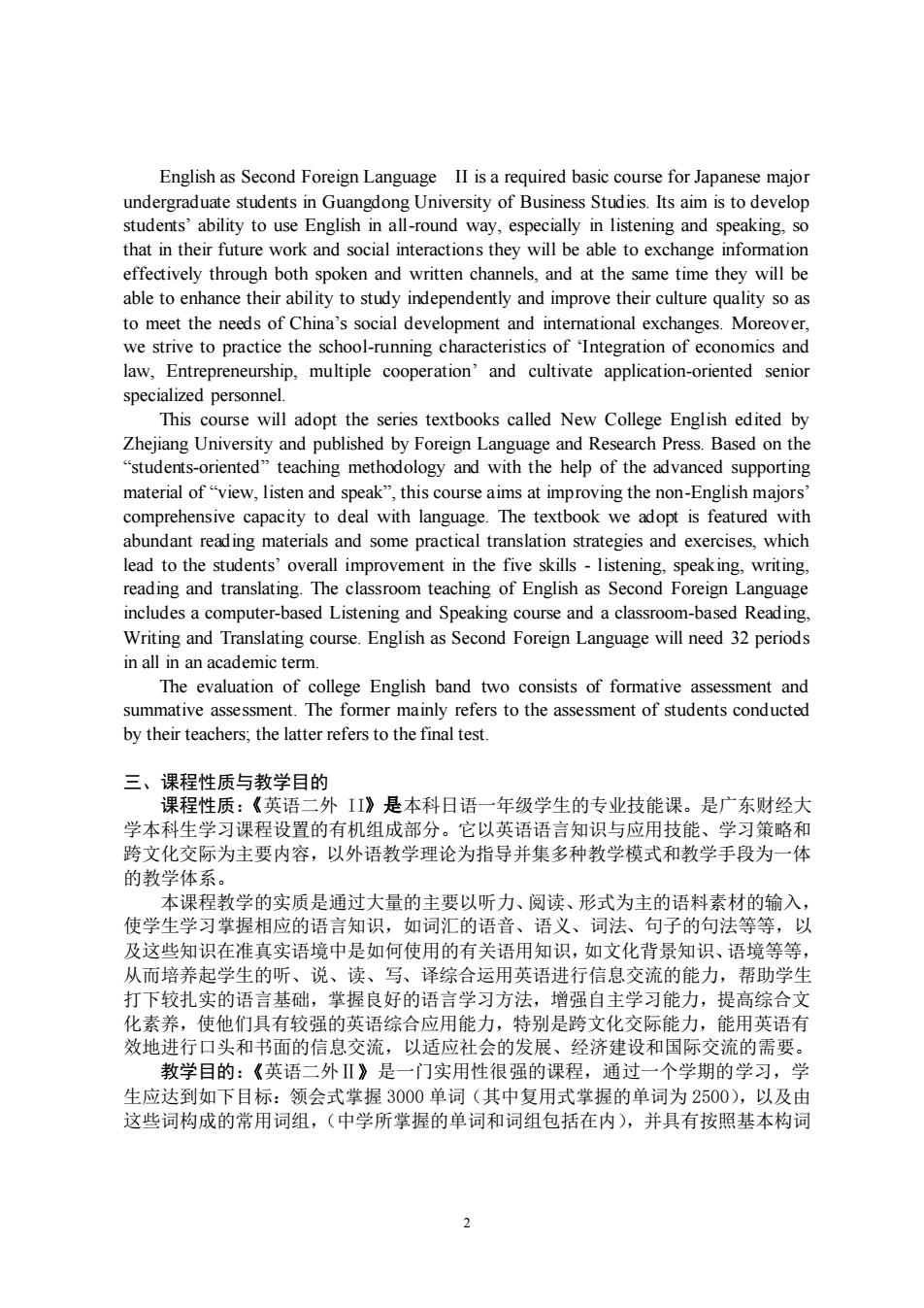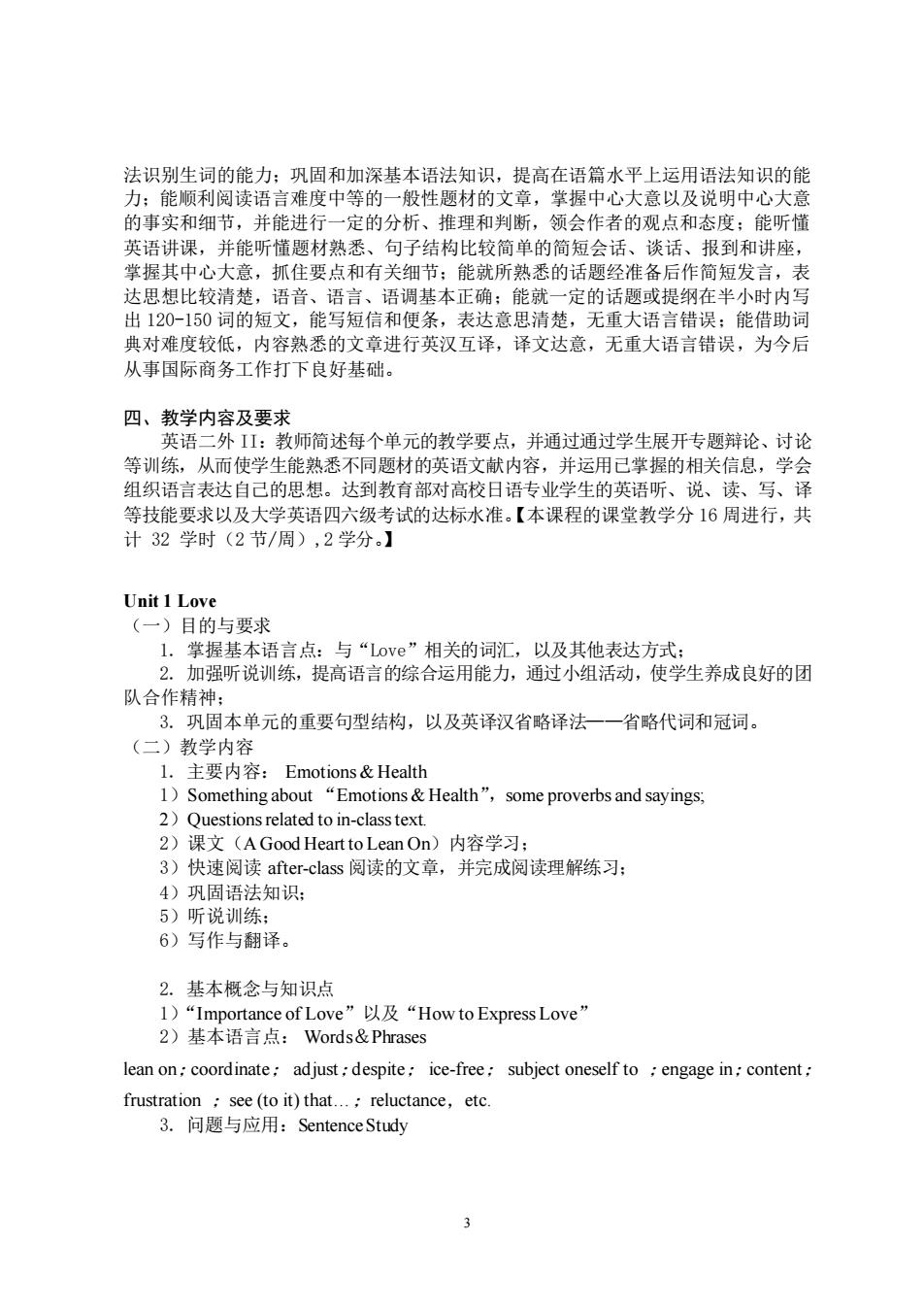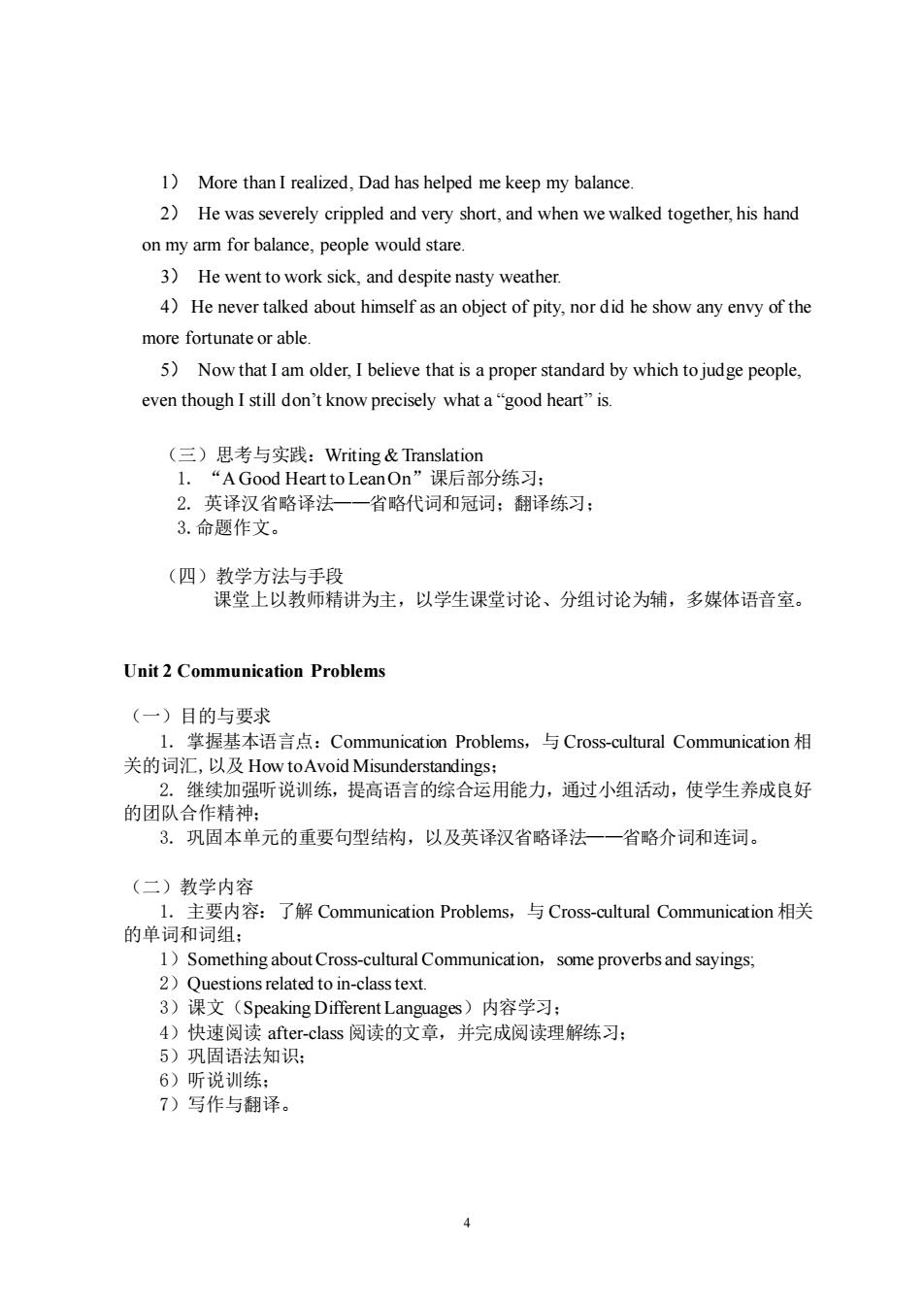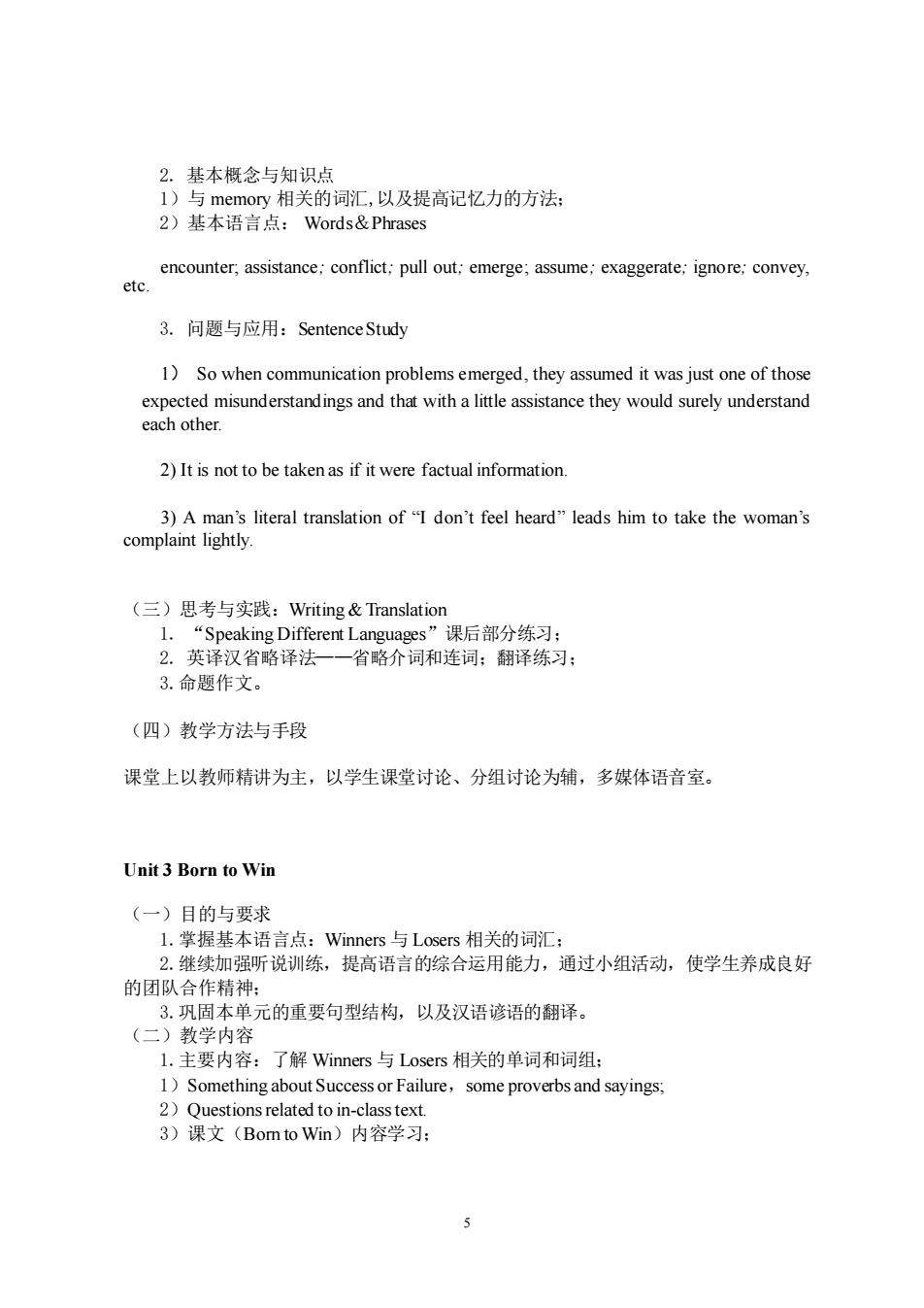
《英语二外1川》课程教学大纲 主讲:彭敬 一、课程基本信息(Basic Course Introduction) 课程代码:16186102 Course Code:16186102 课程名称:英语二外Ⅱ 英文名称:English as Second Foreign LanguageIⅡ 课程类别:专业技能课 ¥ped Skild ome 时:32 Period:32 学分:2 Target Students:Undergraduate Majoring in Japanese 考核方式:考试 Assessment:Examination 先修课程:英语二外【等 Preparatory Course:English as Second Foreign Language I 二、课程简介(Brief Course Introduction) 英语二外Ⅱ是一门英语技能课程,为本科日语专业一年级学生开设的一门必修课 程。该课程的教学目的是培养学生的英语综合应用能力,特别是听说能力,使他们在 今后工作和社会交往中能用英语有效地进行口头和书面的信息交流,周时增强其自主 学习能力 提高综合】 化素质,以适 我国 会发展和国际父流 ,并且努力 践我校“商法融合、实践创业、多元协同”的办学特色和应用型高级专门人才的人才 培养总目标。 本课程的课堂教学采用国家教育部推荐的优秀教材,即浙江大学编著,外语教学 与研究出版社出版的《新编大学英语》,教材保持了第一版阅读量大的特点,改进写 作训练的内容, 增加系统的翻译技巧和练习 读 写、说、 译技 能互为铺垫、相辅 成、全面提高。另外,每个单元都围绕学生关注的话题,提供内容生动有趣的录像短 剧,配有专项口语练习,使学生的五项基本技能得以全面提高。此外,新版的网络课 件增加了一整套结构严谨、设计合理的评估系统,充分发挥了各项功能:整个课件以 满足学生的个性化需求为宗旨。 本课程的课堂教学包括主要基于计算机的听说课程和主要基于课堂教学的读写 译课程,整个学期的课堂教学共32个学时(共16周)。本课程的教学评估包括形成 性评估和终结性评估。前者主要指教师对学生的评估,后者指单独命题组织的期末课 程考试
1 《 英语二外 II 》课程教学大纲 主讲:彭敬 一、课程基本信息(Basic Course Introduction) 课程代码:16186102 Course Code: 16186102 课程名称:英语二外 II 英文名称:English as Second Foreign Language II 课程类别:专业技能课 Course Type: Specialized Skilled Course 学 时:32 Period: 32 学 分:2 Credit: 2 适用对象:日语专业 Target Students: Undergraduate Majoring in Japanese 考核方式:考试 Assessment: Examination 先修课程:英语二外 I 等 Preparatory Course: English as Second Foreign Language I 二、课程简介(Brief Course Introduction) 英语二外 II 是一门英语技能课程,为本科日语专业一年级学生开设的一门必修课 程。该课程的教学目的是培养学生的英语综合应用能力,特别是听说能力,使他们在 今后工作和社会交往中能用英语有效地进行口头和书面的信息交流,同时增强其自主 学习能力,提高综合文化素质,以适应我国社会发展和国际交流的需要。并且努力实 践我校“商法融合、实践创业、多元协同”的办学特色和应用型高级专门人才的人才 培养总目标。 本课程的课堂教学采用国家教育部推荐的优秀教材,即浙江大学编著,外语教学 与研究出版社出版的《新编大学英语》,教材保持了第一版阅读量大的特点,改进写 作训练的内容,增加系统的翻译技巧和练习,读、写、说、译技能互为铺垫、相辅相 成、全面提高。另外,每个单元都围绕学生关注的话题,提供内容生动有趣的录像短 剧,配有专项口语练习,使学生的五项基本技能得以全面提高。此外,新版的网络课 件增加了一整套结构严谨、设计合理的评估系统,充分发挥了各项功能;整个课件以 满足学生的个性化需求为宗旨。 本课程的课堂教学包括主要基于计算机的听说课程和主要基于课堂教学的读写 译课程,整个学期的课堂教学共 32 个学时(共 16 周)。本课程的教学评估包括形成 性评估和终结性评估。前者主要指教师对学生的评估,后者指单独命题组织的期末课 程考试

English as Second Foreign Language II is a required basic course for Japanese major undergraduate students in Guangdong University of Business Studies.Its aim is to develop students'ability to use English in all-round way.especially in listening and speaking.so that in their future work and social interactions they will be able to ex ge inform effectively through both spoken and written channels,and at th esame time they will be able to enhance their ability to study independently and improve their culture quality so as to meet the needs of China's social development and international exchanges.Moreover, we strive to practice the school-running characteristics of 'Integration of economics and law.Entrepreneurship.multipl cooperationand cultivate application-oriented senior specialized personne This course will adopt the series textbooks called New College English edited by Zhejiang University and published by Foreign Language and Research Press.Based on the "students-oriented"teaching methodology and with the help of the advanced supporting material of"view,listen and speak",this course aims at improving the non-English majors' capacity deal with language.The t xtbook ve adopt is feature abundant reading materials and some practical translation strategies and exercises,which lead to the students'overall improvement in the five skills-listening,speaking,writing, reading and translating.The classroom teaching of English as Second Foreign Language includes a computer-based Listening and Speaking course and a classroom-based Reading Writing and Translating course.English as Second Foreign Language will need 32 periods in all in an academic term The evaluation of college English band two consists of formative assessment and summative assessment.The former mainly refers to the assessment of students conducted by their teachers;the latter refers to the final test. 三、课程性质与教学目 理程性质 《耳 外》是本科日语一年级学生的专业技能课。是广东财经大 学本科生学 习课程设置的有机组成部分。它以英语语言知识与应用技能、学习策略利 跨文化交际为主要内容,以外语教学理论为指导并集多种教学模式和教学手段为一体 的教学体系。 本课程教学的实质是通讨大量的主要以听力、阅读、形式为主的语料素材的命入 使学生学习掌握相应的语言知识,如词汇的语音、语义、词法、句子的句法等等,以 及这些知识在准真实语境中是如何使用的有关语用知识,如文化背景知识、语境等等 从而培养起学生的听、说、读、写、译综合运用英语进行信息交流的能力,帮助学生 打下较扎实的语言基础,掌握良好的语言学习方法,增强自主学习能力,提高综合文 化素养,使他们具有较强的英语综合应用能力,特别是跨文化交际能力,能用英语有 效地进行口头和书面的信息交流,以适应社会的发展、经济建设和国际交流的需要。 教学目的:《英语二外Ⅱ》是一门实用性很强的课程, 通 一个学期的学习 生应达到如下目标:领会式掌握3000单词(其中复用式掌握的单词为2500),以及由 这些词构成的常用词组,(中学所掌握的单词和词组包括在内),并具有按照基本构词 2
2 English as Second Foreign Language II is a required basic course for Japanese major undergraduate students in Guangdong University of Business Studies. Its aim is to develop students’ ability to use English in all-round way, especially in listening and speaking, so that in their future work and social interactions they will be able to exchange information effectively through both spoken and written channels, and at the same time they will be able to enhance their ability to study independently and improve their culture quality so as to meet the needs of China’s social development and international exchanges. Moreover, we strive to practice the school-running characteristics of ‘Integration of economics and law, Entrepreneurship, multiple cooperation’ and cultivate application-oriented senior specialized personnel. This course will adopt the series textbooks called New College English edited by Zhejiang University and published by Foreign Language and Research Press. Based on the “students-oriented” teaching methodology and with the help of the advanced supporting material of “view, listen and speak”, this course aims at improving the non-English majors’ comprehensive capacity to deal with language. The textbook we adopt is featured with abundant reading materials and some practical translation strategies and exercises, which lead to the students’ overall improvement in the five skills - listening, speaking, writing, reading and translating. The classroom teaching of English as Second Foreign Language includes a computer-based Listening and Speaking course and a classroom-based Reading, Writing and Translating course. English as Second Foreign Language will need 32 periods in all in an academic term. The evaluation of college English band two consists of formative assessment and summative assessment. The former mainly refers to the assessment of students conducted by their teachers; the latter refers to the final test. 三、课程性质与教学目的 课程性质:《英语二外 II》是本科日语一年级学生的专业技能课。是广东财经大 学本科生学习课程设置的有机组成部分。它以英语语言知识与应用技能、学习策略和 跨文化交际为主要内容,以外语教学理论为指导并集多种教学模式和教学手段为一体 的教学体系。 本课程教学的实质是通过大量的主要以听力、阅读、形式为主的语料素材的输入, 使学生学习掌握相应的语言知识,如词汇的语音、语义、词法、句子的句法等等,以 及这些知识在准真实语境中是如何使用的有关语用知识,如文化背景知识、语境等等, 从而培养起学生的听、说、读、写、译综合运用英语进行信息交流的能力,帮助学生 打下较扎实的语言基础,掌握良好的语言学习方法,增强自主学习能力,提高综合文 化素养,使他们具有较强的英语综合应用能力,特别是跨文化交际能力,能用英语有 效地进行口头和书面的信息交流,以适应社会的发展、经济建设和国际交流的需要。 教学目的:《英语二外Ⅱ》是一门实用性很强的课程,通过一个学期的学习,学 生应达到如下目标:领会式掌握 3000 单词(其中复用式掌握的单词为 2500),以及由 这些词构成的常用词组,(中学所掌握的单词和词组包括在内),并具有按照基本构词

法识别生词的能力:巩固和加深基本语法知识,提高在语篇水平上运用语法知识的能 力:能顺利阅读语言难度中等的一般性题材的文章,掌握中心大意以及说明中心大意 的事实和细节,并能进行一定的分析、推理和判断,领会作者的观点和态度:能听懂 英语讲课,并能听懂题材熟悉、句子结构比较简单的简短会话、谈话、报到和讲座, 抓住要点和有关细节:能就所熟悉的话题经准备后作简短发言 达思想比较清楚,语音、语言、语调基本正确:能就 一定的话题或提纲在半小时内写 出120-150词的短文,能写短信和便条,表达意思清楚,无重大语言错误:能借助词 典对难度较低,内容熟悉的文章进行英汉互译,译文达意,无重大语言错误,为今后 从事因际商务工作打下良好基础。 四、教学内容及要求 英语二外I山:教师简述每个单元的教学要点,并通过通过学生展开专题辩论、讨论 等训练,从而使学生能熟悉不同题材的英语文献内容,并运用已掌握的相关信息,学会 组织语言表达自己的思想。达到教育部对高校日语专业学生的英语听、说、读、写、译 等技能要求以及大学英语四六级考试的达标水准。【本课程的课堂教学分16周进行,共 计32学时(2节/周),2学分.】 Unit 1 Love (一)日的与要 1,掌握基 语言点:与“Love”相关的词汇, 以及其他表达方式 2.加强听说训练,提高语言的综合运用能力,通过小组活动,使学生养成良好的团 队合作精神: 3.巩固本单元的重要句型结构,以及英译汉省略译法一 一省略代词和冠词。 (一)教学内容 主要内容:Emotions&Health Emotions&Health",some proverbs and sayings, 2)Questions related to in-class text. 2)课文(A Good Heart to Lean On)内容学习; 3)快速阅读after-class阅读的文章,并完成阅读理解练习: 4)巩固语法知识 5)听说训绮 6)写作与翻译。 2.基本概念与知识点 13“1 rtance of Love”以及“How to Express Love” 2)基本语言点: Words&Phrases lean on:coordinate:adjust:despite:ice-free:subject oneself to :engage in:content: frustration:see(to it)that...:reluctance,etc. 3.问题与应用:SentenceStudy 3
3 法识别生词的能力;巩固和加深基本语法知识,提高在语篇水平上运用语法知识的能 力;能顺利阅读语言难度中等的一般性题材的文章,掌握中心大意以及说明中心大意 的事实和细节,并能进行一定的分析、推理和判断,领会作者的观点和态度;能听懂 英语讲课,并能听懂题材熟悉、句子结构比较简单的简短会话、谈话、报到和讲座, 掌握其中心大意,抓住要点和有关细节;能就所熟悉的话题经准备后作简短发言,表 达思想比较清楚,语音、语言、语调基本正确;能就一定的话题或提纲在半小时内写 出 120-150 词的短文,能写短信和便条,表达意思清楚,无重大语言错误;能借助词 典对难度较低,内容熟悉的文章进行英汉互译,译文达意,无重大语言错误,为今后 从事国际商务工作打下良好基础。 四、教学内容及要求 英语二外 II:教师简述每个单元的教学要点,并通过通过学生展开专题辩论、讨论 等训练,从而使学生能熟悉不同题材的英语文献内容,并运用已掌握的相关信息,学会 组织语言表达自己的思想。达到教育部对高校日语专业学生的英语听、说、读、写、译 等技能要求以及大学英语四六级考试的达标水准。【本课程的课堂教学分 16 周进行,共 计 32 学时(2 节/周),2 学分。】 Unit 1 Love (一)目的与要求 1. 掌握基本语言点:与“Love”相关的词汇,以及其他表达方式; 2. 加强听说训练,提高语言的综合运用能力,通过小组活动,使学生养成良好的团 队合作精神; 3. 巩固本单元的重要句型结构,以及英译汉省略译法——省略代词和冠词。 (二)教学内容 1. 主要内容: Emotions & Health 1)Something about “Emotions & Health”,some proverbs and sayings; 2)Questions related to in-class text. 2)课文(A Good Heart to Lean On)内容学习; 3)快速阅读 after-class 阅读的文章,并完成阅读理解练习; 4)巩固语法知识; 5)听说训练; 6)写作与翻译。 2. 基本概念与知识点 1)“Importance of Love”以及“How to Express Love” 2)基本语言点: Words&Phrases lean on;coordinate; adjust;despite; ice-free; subject oneself to ;engage in;content; frustration ;see (to it) that…;reluctance,etc. 3. 问题与应用:Sentence Study

1)More than I realized,Dad has helped me keep my balance 2)He was severely crippled and very short.and when we walked together,his hand on my arm for balance,people would stare. 3)He went to work sick,and despite nasty weather. 4)He never talked about himself as an object of pity,nor did he show any envy of the more fortunate or able. 5)Now that I am older,I believe that is a proper standard by which tojudge people, even though I still don't know precisely what a"good heart"is. (三)思考与实践:Writing&Translation 1.“A Good Heart to LeanOn”课后部分练习: 2.英译汉省略译法一一省略代词和冠词;翻译练习: 3.命题作文。 (四)教学方法与手段 课堂上以教师精讲为主,以学生课堂讨论、分组讨论为辅,多媒体语音室。 Unit 2 Communication Problems (一)目的与要求 L.掌握基本语言点:Communication Problems,.与Cross-cultural Communication相 关的词汇,以及How toAvoid Misunderstandings: 2.继续加强听说训练,提高语言的综合运用能力,通过小组活动,使学生养成良好 的团队合作精神: 3。巩固本单元的重要句型结构,以及英译汉省略译法一一省略介词和连词 (二)教学内容 1.主要内容:了解Communication Problems,与Cross-cultural Communication相关 的单词和词组: 1)Something about Cross-cultural Communication,some proverbs and sayings 2Questions related to in-classtext 3)课文(Speaking Different Languages)内容学习: 4)快速阅读after--class阅读的文章,并完成阅读理解练习: 5)巩固语法知识: 6)听说训练: 7)写作与翻译
4 1) More than I realized, Dad has helped me keep my balance. 2) He was severely crippled and very short, and when we walked together, his hand on my arm for balance, people would stare. 3) He went to work sick, and despite nasty weather. 4)He never talked about himself as an object of pity, nor did he show any envy of the more fortunate or able. 5) Now that I am older, I believe that is a proper standard by which to judge people, even though I still don’t know precisely what a “good heart” is. (三)思考与实践:Writing & Translation 1. “A Good Heart to Lean On”课后部分练习; 2. 英译汉省略译法——省略代词和冠词;翻译练习; 3.命题作文。 (四)教学方法与手段 课堂上以教师精讲为主,以学生课堂讨论、分组讨论为辅,多媒体语音室。 Unit 2 Communication Problems (一)目的与要求 1. 掌握基本语言点:Communication Problems,与 Cross-cultural Communication 相 关的词汇,以及 How to Avoid Misunderstandings; 2. 继续加强听说训练,提高语言的综合运用能力,通过小组活动,使学生养成良好 的团队合作精神; 3. 巩固本单元的重要句型结构,以及英译汉省略译法——省略介词和连词。 (二)教学内容 1. 主要内容:了解 Communication Problems,与 Cross-cultural Communication 相关 的单词和词组; 1)Something about Cross-cultural Communication,some proverbs and sayings; 2)Questions related to in-classtext. 3)课文(Speaking Different Languages)内容学习; 4)快速阅读 after-class 阅读的文章,并完成阅读理解练习; 5)巩固语法知识; 6)听说训练; 7)写作与翻译

2.基本概念与知识点 1)与memory相关的词汇,以及提高记忆力的方法: 2)基本语言点:Words&Phrases encounter,assistance:conflict:pull out:emerge:assume:exaggerate:ignore:convey. 3.问题与应用:SentenceStudy 1)So when communication problems emerged,they assumed it was just one of those expected misunderstandings and that with a little assistance they would surely understand each other. 2)It is not to be takenas if it were factual information 3)A man's literal translation of"I don't feel heard"leads him to take the woman's complaint lightly. (三)思考与实践:Writing&Translation 1.“Speaking Different Languages”课后部分练习: 2.英译汉省略译法 一省略介词和连词:翻译练习: 3.命题作文。 (四)教学方法与手段 课堂上以教师精讲为主,以学生课堂讨论、分组讨论为辅,多媒体语音室。 Unit 3 Born to Win (一)目的与要求 L.学握基本语言点:Winners与Losers相关的词汇: 2.继续加强听说训练,提高语言的综合运用能力,通过小组活动,使学生养成良好 的团队合作精神: 3.巩周本单元的重要句型结构,以及汉语谚语的翻译。 (二)教学内容 L.主要内容:了解Winners与Losers相关的单词和词组 1)Something about Success or Failure,some proverbs and sayings, 2)Questions related to in-classtext 3)果文(Born to Win)内容学习: 5
5 2. 基本概念与知识点 1)与 memory 相关的词汇,以及提高记忆力的方法; 2)基本语言点: Words&Phrases encounter; assistance; conflict; pull out; emerge; assume; exaggerate; ignore; convey, etc. 3. 问题与应用:Sentence Study 1) So when communication problems emerged, they assumed it was just one of those expected misunderstandings and that with a little assistance they would surely understand each other. 2) It is not to be taken as if it were factual information. 3) A man’s literal translation of “I don’t feel heard” leads him to take the woman’s complaint lightly. (三)思考与实践:Writing & Translation 1. “Speaking Different Languages”课后部分练习; 2. 英译汉省略译法——省略介词和连词;翻译练习; 3.命题作文。 (四)教学方法与手段 课堂上以教师精讲为主,以学生课堂讨论、分组讨论为辅,多媒体语音室。 Unit 3 Born to Win (一)目的与要求 1.掌握基本语言点:Winners 与 Losers 相关的词汇; 2.继续加强听说训练,提高语言的综合运用能力,通过小组活动,使学生养成良好 的团队合作精神; 3.巩固本单元的重要句型结构,以及汉语谚语的翻译。 (二)教学内容 1.主要内容:了解 Winners 与 Losers 相关的单词和词组; 1)Something about Success or Failure,some proverbs and sayings; 2)Questions related to in-class text. 3)课文(Born to Win)内容学习;